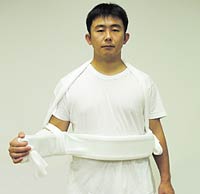Patients immobilized in external rotation avoid recurrent dislocations
Adjustment in bracing better replicates normal positioning of healthy shoulder.
NEW ORLEANS — Patients with an anterior dislocation of the glenohumeral joint have had a 0% recurrence rate when immobilized in external rotation, according to the early results of a Japanese study.
At the American Shoulder and Elbow Surgeons Specialty Day, Eiji Itoi, MD, of the Akita University School of Medicine in Japan, said orthopedic surgeons need to begin questioning the practice of bracing anterior dislocations with internal rotation if they want to reduce the likelihood of recurrent dislocations.
Recurrent dislocations have been reported in 66% to 94% of young patients after internal rotation bracing. Itoi said that external rotation prevents separation of the anterior capsule from the scapular neck and also prevents displacement of the anterior labrum.
“We have been using [internal rotation] for over 2000 years, since the era of Hippocrates,” Itoi said. “But to our surprise, there has been no study whatsoever to answer the question of whether this is the best way to heal a Bankart lesion.”
Follows previous investigations
After previously publishing studies that illustrated the benefits of external rotation both in cadavers and on magnetic resonance imaging, Itoi began a prospective, randomized clinical study in January 2000.
 --- Patients fitted with a special brace keeping the shoulder in external rotation had a 0% rate of recurrent dislocations at mean 16-month follow-up.
--- Patients fitted with a special brace keeping the shoulder in external rotation had a 0% rate of recurrent dislocations at mean 16-month follow-up.
COURTESY OF EIJI ITOI
Forty patients with initial anterior dislocation of the glenohumeral joint were randomized into either an internal rotation (IR) or external rotation (ER) group. Mean age was about 40 in both groups.
Investigators attained immobilization in the ER group with a special design that used a splint and a stockinette to fix the shoulder in about 10º of rotation. IR group immobilization was attained with a common splint.
Due to the cumbersome nature of the ER brace, Itoi said he allowed patients to loosen the stockinette while sleeping to permit them to extend their elbow a little bit while the shoulder remained in external rotation.
Itoi prescribed three weeks of immobilization for both groups, although he questioned whether this was the ideal immobilization period, since it has never been proven in clinical trials. After three weeks, patients were permitted unrestricted range of motion.
Compliance
Patient compliance was a problem in both groups. Five patients in the IR group and four in the ER group reported that they had discarded the immobilizer within one week. Itoi said that young, active patients were most likely to be noncompliant.
Overall results were compiled with an average follow-up of 16 months.
Itoi found that six of the 20 patients in the IR group had recurrent dislocations, compared to none in the ER group (P=.0079). Among patients younger than 29 years of age, recurrent fractures occurred in five of 11 patients in the IR group (45%) compared to zero of 11 patients in the ER group (P=.0110).
Investigators also used an anterior apprehension test to evaluate success of the procedure. Overall, two of 14 patients in the IR group tested positive (14%) as opposed to two of 20 in the ER group (10%).
Itoi said a larger cohort study is underway to confirm the results of the earlier findings.
“This study clearly demonstrated that immobilization in external rotation is better than in internal rotation in terms of reducing recurrent dislocations,” Itoi said. “However, we do not think that external immobilization completely stops the onset of recurrent dislocations. Patients who showed positive anterior apprehension tests may suffer recurrent dislocations in the long run.”
For your information:
- Itoi E, Hatakeyama Y, Kido T, et al. A new method of immobilization after dislocation of the shoulder: a prospective, randomized study. Presented at the American Shoulder and Elbow Surgeons Specialty Day. Feb. 8, 2003. New Orleans.
